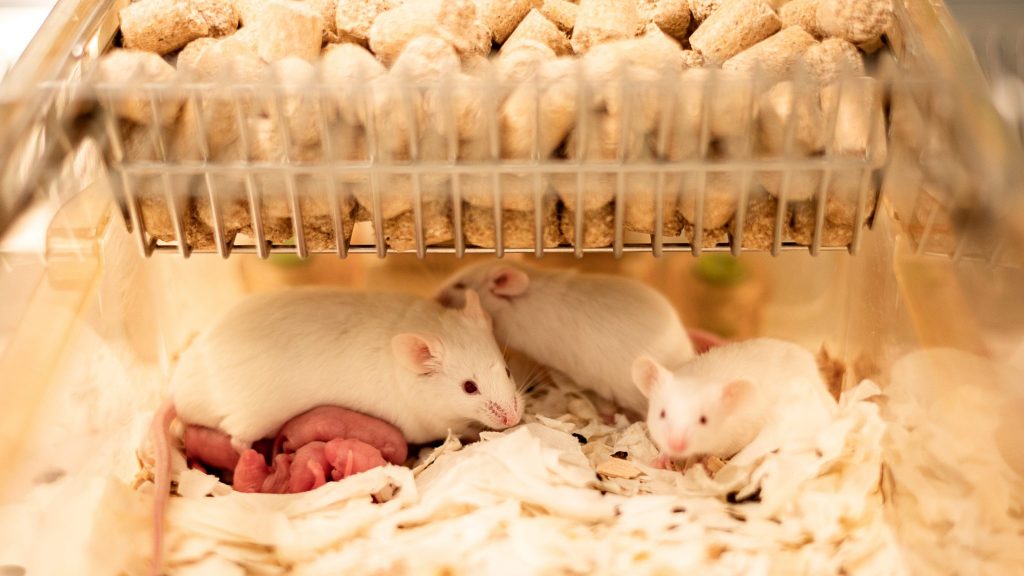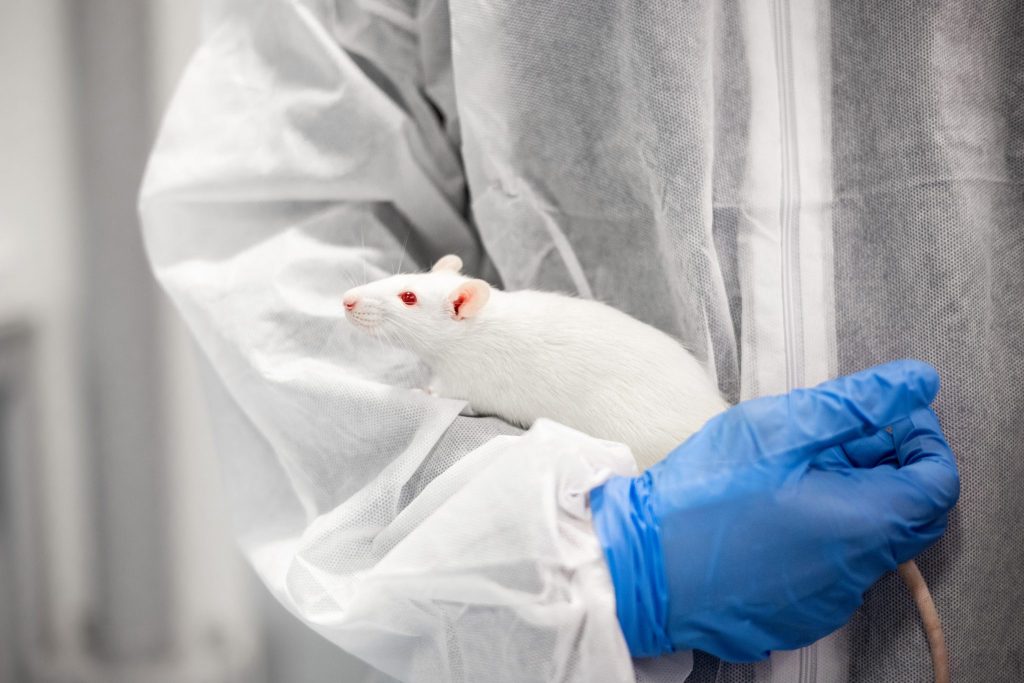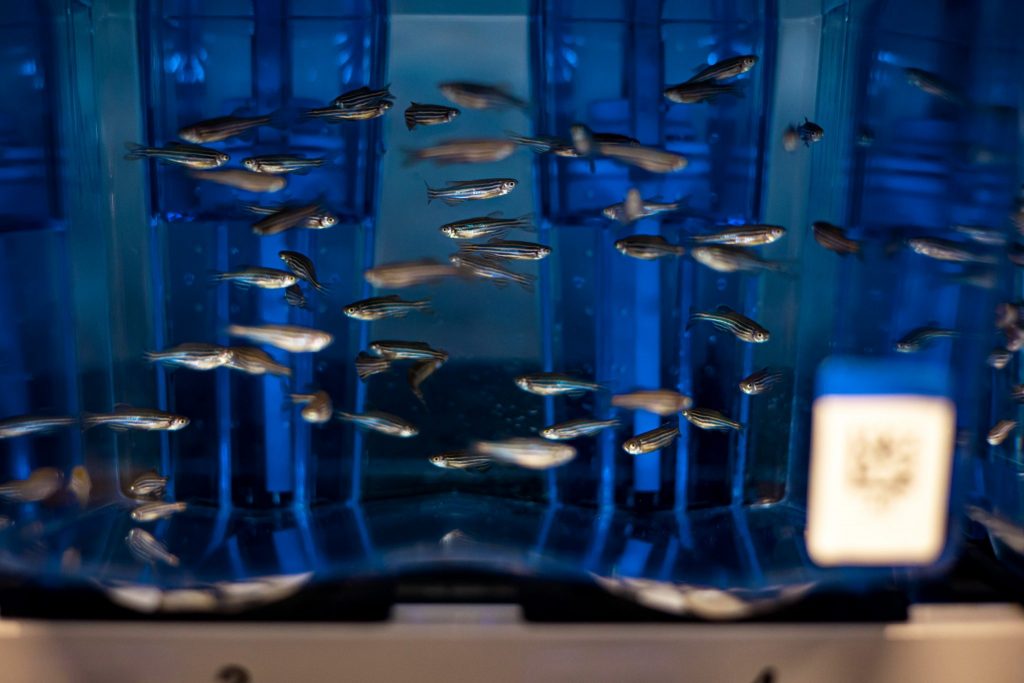Our facilities house mice – which are used in the large majority of animal research – as well as rats, zebrafish, and tadpoles. The use of animals in research at EPFL is not systematic, and takes place only when there is no alternative.
Mouse

The mouse shares a very high genetic similarity with humans (over 90%), and shows all assets for breeding in a laboratory setting: numerous offspring, rapid development, and small size. These features make it the most common animal model used in research. Various inbred mouse lines are commonly used (e.g. BALB/c, C57BL/6), while the genome of the mouse can be modified to block the activity of certain genes (knock-out mice) or to express new genes (transgenic mice). These particular models contribute widely to the study of human diseases such as cancer, Alzheimer’s disease, diabetes. In 2020, mice represented 93% of all research animals used at EPFL and took part in a variety of studies on cancer, neurobiology, immunity, metabolism, genetics, cell and membrane biology, and others.
Rat

Rats were the first mammalian species to be domesticated and raised in the laboratory. Their long history has made them standard models in various fields of research. Several rat lines are commonly used, such as the albinos Wistar or Sprague Dawley rats. Rats are very capable when it comes to learning tasks, so behavioral research often relies on them. Scientists might also decide to replace mice with rats for their bigger size, allowing easier procedures or, in some cases, sampling. In 2020, rats represented 6.3% of all animals used at EPFL, and were mostly involved in behavioral experiments.
Fish

Over the last few decades, fish models become increasingly important in basic and applied research, including biomedicine, toxicology, environmental science, biotechnology and aquaculture. This is particularly true for zebrafish, a small tropical freshwater fish whose name comes from the dark stripes on its body. Zebrafish are now considered a highly interesting vertebrate animal model thanks to their small size (3 to 5 cm), optical transparency, large number of offspring (up to 200 eggs per female), and the extra-uterine development of embryos. Although humans may appear to be extremely different from zebrafish, we share around 70% of our genes.
To date, several human diseases such as Duchenne muscular dystrophy and melanoma have been successfully modeled in zebrafish. In 2020, they represented 0.5% of all research animals used at EPFL, mostly used in developmental, behavioral, and immunological studies.
Xenopus frog
In some cases, other animal models need to be selected as they are best suited to help answering the questions asked by scientists. For example, some researchers occasionally work with the Xenopus frog, an African frog species used as a research model since the early 1900s. Xenopus has made crucial contributions to our understanding of cell biology, developmental biology, and cell signaling. As they were only recently housed at EPFL, no statistics are available yet.
Other species
Flies and worms
Researchers at EPFL employ Drosophila melanogaster, commonly called fruit flies, to understand infection biology, gene regulation, motor control, brain evolution and neurodegenerative diseases. It has been employed as a model organism for biological research for over 100 years. Thanks to this sustained investigation, it is one of the most fully understood animal models in all of biomedical science with sophisticated molecular and genetic tools not available in other model systems. It has many genetic, physiological and behavioural similarities to humans. Research using fruit flies have laid the foundations for many aspects of modern medicine and biology including our understanding of development, immunity and neuroscience.
While the fruit fly has a long history as a model organism, the nematode worm (Caenorhabditis elegans) has been used as a model organism since the early 1960s. Much simpler than humans (it doesn’t have bones, a heart or a circulatory system), it however shares many of the essential biological characteristics that are central problems of human biology. All 959 somatic cells of its transparent body are visible with a microscope, and its average life span is a mere 2-3 weeks, which is useful for studying their development. Thus C. elegans, which also was the first multicellular organism to have its whole genome sequenced, provides the researcher with the ideal compromise between complexity and tractability. Some research groups at EPFL use this worm to study fundamental cellular processes and muscle or neuronal decline.
Insects, like Drosophila, or worms, like C. elegans, are not protected by the Animal Protection Ordinance. However, researchers at EPFL are governed by the regulations from the Federal Office of Public Health to do experiments.
Species not housed on EPFL campus
Researchers at EPFL occasionally need to conduct experiments on other animals. For example, in the field of neurorehabilitation, researchers sometimes need to study non-human primates. In these models of neurological disorders, the scientists test neuro-regenerative interventions, with the goal of restoring motor function and improving quality of life for people with motor impairments. EPFL does not house non-human primates, so these experiments are performed at specialized centers specifically created for these species.